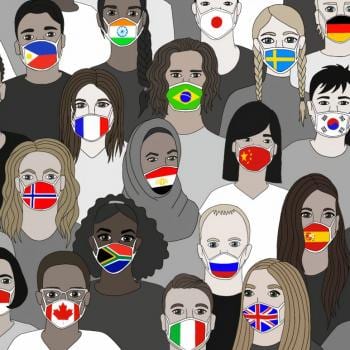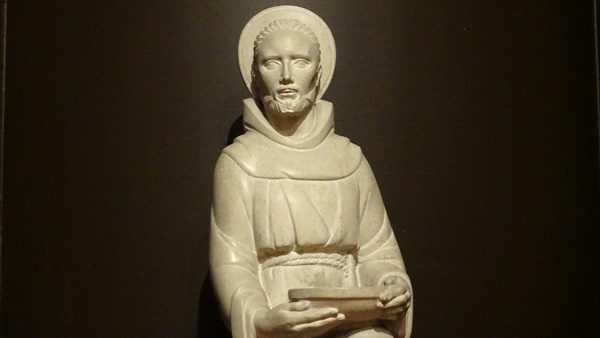Welcome to the Girardian Virtual Bible Study! Each week we explore the lectionary passage with the help of René Girard’s insights into human relationships. We hope you enjoy this installment of the GVBS. Join us next week at 10:30 am Central on the Raven Foundation Facebook page for the live show. The show notes and video recording are below. This week’s episode explores Good Friday, Year C, John 18:1-19:42.
It’s Holy Week for Christians, which raises the question, “What’s so good about Good Friday?”
After all, it’s the day Jesus was murdered. Shouldn’t it be called, “Worst day ever Friday?”
Christians throughout the century have claimed Good Friday is good because on this day Jesus made Atonement. Atonement is a good thing, but there has never been an official teaching – let alone an unofficial teaching that all Christians agree upon – that describes just how Jesus made this atonement between God and humanity.
What Is Atonement?
Atonement can be understood by parsing the word: at-one-ment. We are meant to be at one with God and our fellow human beings. But we tend to see ourselves as separate individuals. The myth of individualism leaves us isolated. The truth is that we are inter-connected through the image of God that exists within us all. As Girard claims, we are not individuals; rather, we are interdividuals.
Jesus came to bring this at-one-ment to us. He prayed to his Father, “May they be one, as you and I are one.”
But how does the cross create this Atonement? One answer Christians have given is that God is holy and so God is really angry at human sin. Because God is infinitely just, God cannot just forgive sin – God needs to punish it! So, God sent the Son to the cross in order to drink the cup of God’s wrath.
But the Gospels never say that. In fact, the Gospels make it very clear that Jesus forgave people of their sins during his life and ministry. His ministry was about the forgiveness of sins. Jesus did not have to go to the cross in order for people to be forgiven. He freely forgave people.
Jesus reveals that God’s holiness does not avoid sinner, prostitutes, and tax collectors – the scapegoats of culture – God’s holiness is seen in Jesus’ ability to be friends with them.
The Cup of Human Wrath
In our passage, Jesus does say he must drink the cup that the Father has given him. But the cup the Father gives him to drink was the cup of nonviolent love. The cup people gave him was the cup of wrath.
That’s the key point of Good Friday. The Divine Cup that Jesus drinks is the cup of nonviolent love and forgiveness. The human cup Jesus drinks is the cup of violence and shame.
The Gospel of John makes this very clear through the religious elite of Jesus’ day. Caiaphas, the high priest, advised “that it was better to have one person die for the people.” The Gospels show that the cross was not God’s plan. It was Caiaphas’s plan. The cross was Rome’s plan.
God’s plan was different. God’s plan was for Jesus to remain nonviolent and non-wrathful. That’s why when Peter took his sword to violently protect Jesus from being arrested, Jesus responded, “Put your sword back into its sheath.” Jesus didn’t respond to human violence with his own wrathful violence. In fact, when Peter cut off a man’s ear to protect Jesus, Jesus healed the man’s ear! Jesus atoned for Peter’s violence by healing the man’s ear. Jesus reveals that the Kingdom of God has nothing to do with violence – except to transform it through forgiveness and healing.
Our passage reveals God’s nonviolence in another way, too. Jesus came face to face with Pilate, Rome’s governmental authority in Judea. Pilate held the “key” to Roman peace – it was the key of violence. Pilate had the authority to thrust someone upon the cross.
Pilate asked Jesus if he was the King of the Jews. Jesus responded rather cryptically, saying, “My Kingdom is not from this world.” Many have interpreted this as Jesus saying his kingdom is in heaven, which is somewhere far away in a spiritual realm. Thus, the reasoning goes, let Rome do what Rome’s going to do because the Kingdom of God has no bearing in governmental authorities.
But that’s false. In Jesus, the Kingdom of God concretely enters into the world. God is at one with the world through Jesus’ life, death, resurrection, and ascension. It’s not that there is a dualism between a spiritual realm (called the Kingdom of God) and a physical realm (in the case of the Gospels, the Empire of Rome). The truth is that the spiritual realm is one with the physical realm.
The Cup of Divine Love
But the world that Jesus is not part of is the world of violence. That’s why Jesus continues, “If my Kingdom were from this world, my followers would be fighting to keep me from being handed over to the Jews. But as it is, my kingdom is not from here.” The “this world” that Jesus refers to is the world of reciprocal violence. The Kingdom of God that Jesus brings to earth transforms “this world” of violence that humans have created into a world of nonviolent love.
Jesus went to the cross because God’s cup is the cup of love, even love for those we call our enemies. It’s a cup we are called to drink as followers of Jesus. It’s the cup of love that stops the cycle of violence and scapegoating. It’s the cup of abundance that freely heals those who are sick, feeds those who are hungry, sets the prisoners free, ends wars, and welcomes the immigrant.
Because according to the Atonement of Good Friday, it’s not God’s wrath we need to be saved from. It’s our own.












